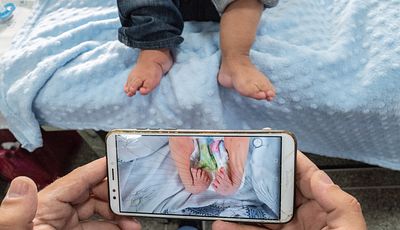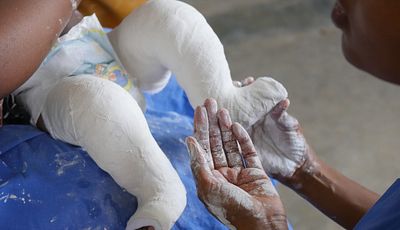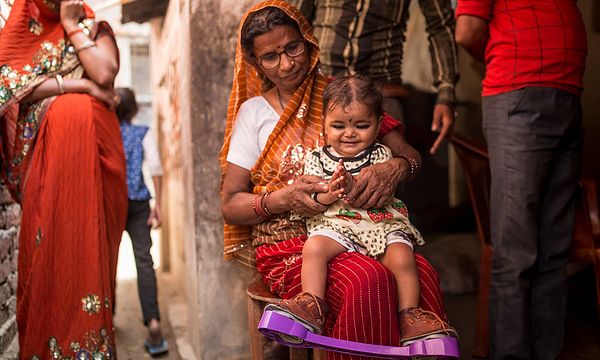New report calls for global action for children and adults with clubfoot
A new report by the Clinton Health Access Initiative (CHAI) for AT2030, a UK Aid-funded program led by the Global Disability Innovation Hub (GDI Hub), aims to drive progress for children and adults with clubfoot to reach their full potential.
Clubfoot, a leading birth defect, affects an estimated 200,000 children a year, 144,000 of whom cannot access its treatment. Although it affects more children than most other structural birth defects, and even though virtually all children can achieve lifelong mobility without surgery, many governments and bilateral donors still do not view clubfoot intervention as a priority newborn health issue.
CHAI and GDI Hub feel that now is the time to address this inequality, providing renewed momentum to a dedicated and long-established movement.


The AT2030 report on impairment related to clubfoot is the first of its kind by a global development agency to specifically investigate the barriers to clubfoot treatment in low- and middle-income countries (LMICs). The report brought together some of the most knowledgeable stakeholders in the sector and includes a number of high-impact, evidence-based recommendations.
The report finds that in order to increase access to clubfoot services in LMICs in particular, there is an urgent need to develop global guidelines to bolster government-led ownership, increase financing, and coordinate strategies for mainstreaming clubfoot’s standard of care, the Ponseti method, across health systems. “There is no consensus or agreed treatment guidelines by the WHO that include the Ponseti method. This contributes to a lack of integration of clubfoot services within government-led systems for neonatal and child health care,” the report finds. Clubfoot is included in WHO’s congenital anomaly surveillance and monitoring guidance, launched in December 2020; however, strategies related to this effort have not yet prioritized or targeted clubfoot interventions.
The Ponseti method is non-surgical and restores full mobility in over 95% of cases. “It’s a preventable disability,” MiracleFeet’s President Daphne Sorensen said in a recent interview with Devex. “We must engage donors and development finance institutions, from USAID to the World Bank, to invest more in disabilities like untreated clubfoot and also assistive technology and rehabilitation services proportional to these problems.” She goes on to say, “if we come together to recognize that this issue exists, recognize that it’s been woefully underfunded and neglected, and put together a global strategy, we can actually solve this problem.”
Indeed, the need for additional investment is a key finding of the report: “[In order] to increase access to clubfoot services in LMICs, further investment is needed to achieve the vision of a world where thousands of children each year can receive treatment and therefore avoid a life-long impairment” writes the lead author. Since 2000, G7 donors have invested less than $6 million USD total in clubfoot treatment, and none of the $103 billion of development assistance invested in newborn and child health initiatives globally has gone towards addressing clubfoot.
GDI Hub also aims to address the issue of investment through the AT2030 programme, which established the AT Impact Fund (ATIF), designed to support disability innovation ventures to scale through the use of capital and technical assistance. Miracle Feet is one of the first organizations to benefit from ATIF.
“Increasing access to clubfoot treatment in LMICs will require a multi-faceted approach that combines interventions that address global barriers to access, encourage government and donor prioritisation, and accelerate the scale-up of models and tools that increase capacity,” AT2030 and partners conclude. They offer a detailed list of recommendations for global to national actors to create policies, train personnel, and ensure supply chains for treatment materials and assistive products.


Vicki Austin, CEO of GDI Hub, highlighted further the significance of the report: “This report wasn’t supposed to be written. The researchers discovered so much evidence related to clubfoot when writing the Product Narrative for prosthetics that we collectively felt a duty to publish it, and of course, that makes the need for it self-evident. Children and adults with clubfoot should not be left behind.” Frederick Seghers, director of global markets for CHAI, authored the report in consultation with clubfoot sector experts and partners from the AT2030 programme and ATscale, the Global Partnership for Assistive Technology.
The research is part of GDI Hub’s AT2030 work with WHO and UNICEF to drive global affordability and availability of assistive products through market-shaping, which includes the production of 26 essential Assistive Product Specifications to guide countries in assistive product provision. The WHO has also produced the Assistive Product’s List which can aid national government to prioritize assistive products in health systems supply chains. Clubfoot braces have been included in the first ever APS, a global guide for assistive technology to improve the life of millions, which WHO, AT2030, and UNICEF launched in March 2021.
Read more: Preventing lifelong impairment: Access to clubfoot treatment in low- and middle-income countries.
News story and photographs credited to MiracleFeet.